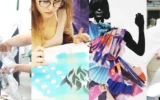Organizing and executing a fashion show is no easy task. It takes a lot of hard work, planning, and dedication to pull off a successful event. However, there are some tried-and-true tips that can help make the process smoother and more successful. In this article, we will discuss 7 tips for a successful fashion show and how to use them to ensure your event runs smoothly.
Fashion Show Basics
- Plan Ahead: One of the most important things you can do to ensure a successful fashion show is to plan ahead. This includes everything from choosing your models and designing your clothing to booking a venue and creating a schedule for the event.
- Select the Right Models: The models you choose for your fashion show will play an integral role in its success. Look for models who embody the look and feel of your brand, but also those who have experience walking in runway shows.
- Create a Strong Theme: A strong theme can help tie together all aspects of your fashion show, from the clothing designs to the music selection and overall atmosphere.
- Build Hype on Social Media: In today’s digital age, social media can be one of the most effective tools for building hype around your fashion show. Use platforms like Instagram and Twitter to showcase sneak peeks of your clothing designs or behind-the-scenes looks at model fittings.
- Have Great Music: Music sets the tone at any event, so make sure you have great tunes playing during your fashion show.
- Pay Attention to Lighting and Sound: Lighting and sound are two key elements that can greatly enhance or detract from a fashion show’s overall impact.
- Follow-Up with Attendees: After hosting a successful fashion show, it’s important to follow up with attendees and thank them for their support while also asking for feedback on how you could improve future events.
Tip 1: Select the Theme
Selecting a theme is the first and foremost important step for a successful fashion show. A well-thought-out theme provides guidance to the event planning, from selecting models to music and set design. It should be creative, coherent, and relevant to your target audience. For instance, if you are targeting millennials, incorporating pop culture references or social media trends could resonate with them.
Once you have selected a theme, it is essential to create a storyboard that outlines the entire event’s vision. This will help ensure that every element of your fashion show aligns with your chosen concept’s overall message. The storyboard should include details such as hair and makeup looks, lighting effects, runway design, and even the order in which models will walk down the runway.
When it comes to executing your chosen theme on stage, attention to detail is key. Pay attention to every aspect of your presentation – from the models’ attire down to their accessories – ensuring everything fits seamlessly into your desired aesthetic. A cohesive presentation will keep attendees engaged throughout the show while also reinforcing your brand’s message through visual storytelling techniques.
Tip 2: Develop Concept
Developing a concept for your fashion show is crucial to creating a successful event. Start by determining the purpose and theme of your show. Are you launching a new collection or showcasing multiple designers? Is your theme bold and edgy or classic and elegant? Once you have established these factors, brainstorm ideas that will make your concept stand out from other fashion shows.
Consider incorporating unique elements such as live music, interactive installations, or unexpected venues. These can help elevate the overall experience for attendees and create buzz around your event. Additionally, don’t forget to consider practical aspects such as lighting and set design that will enhance the presentation of your garments.
Finally, ensure that all aspects of your concept align with your brand identity and target audience. Your fashion show should be an extension of your brand’s values and aesthetic. Keep in mind what message you want to convey through this event and how it can leave a lasting impression on attendees. A well-developed concept can make all the difference in creating a memorable and successful fashion show.
Tip 3: Choose Models.
When it comes to a fashion show, models play a crucial role in showcasing the designer’s vision. Choosing the right models can make or break a show. It is important to select models who fit the aesthetic of your brand and complement your clothing designs.
One way to ensure that you are selecting appropriate models is by considering their measurements, height, and overall look. Look for models who have similar body types to those you envision wearing your clothes. Additionally, consider diversity when choosing models to represent your brand as this helps showcase inclusivity and reach a wider audience.
It is also essential to communicate with potential models about expectations and requirements beforehand so that they can prepare accordingly. This could include fitting sessions, rehearsals, hair & makeup consultations, etc., ensuring that all aspects of the show run smoothly on the day of the event.
Tip 4: Plan Music & Lighting
Music and lighting play a crucial role in setting the mood for any fashion show. The right music can set the tempo of the show while lighting can highlight the models’ features and outfits. To plan these elements, start by considering your theme and target audience. What kind of music would they enjoy? Would you prefer live performances or recorded tracks? Additionally, think about how many models will be on stage at once to coordinate lighting to ensure everyone is highlighted.
When it comes to lighting, keep in mind that different colors evoke different emotions. Warm tones like red and orange create excitement while cooler tones like blue or green convey calmness or elegance. You may want to have some areas with more dramatic lighting for certain segments of your show but also consider softer lights when showcasing delicate pieces.
In conclusion, planning music and lighting requires careful consideration as they are significant aspects of a successful fashion show. It is essential to select appropriate music genres that align with the event’s theme and targeted audience while coordinating various types of lighting for each segment accordingly. A well-executed plan will enhance the ambiance of your fashion show, keeping guests engaged throughout its duration.
Tip 5: Create a Mood Board
A mood board is a collage of images and materials that represent the desired aesthetic and atmosphere of your fashion show. Creating a mood board can help you solidify your vision and communicate it to others involved in the planning process. Start by gathering inspiration from magazines, websites, social media, and any other sources that align with your theme or style. Once you have a collection of images, arrange them on a physical or digital board to create a cohesive visual representation of your concept.
When creating your mood board, keep in mind the colors, textures, patterns, and overall vibe you want to convey through your fashion show. This will help guide decisions for everything from clothing choices to lighting design. Additionally, sharing your mood board with designers and vendors can ensure everyone is on the same page and working towards a unified vision.
Incorporating a mood board into the planning process can elevate the overall production value of your fashion show while also providing clarity for all involved parties. By taking the time to curate an inspirational collection of visuals that accurately represents your concept, you set yourself up for success in executing an unforgettable event.
Tip 6: Ensure Professionalism.
One of the most important aspects of any fashion show is professionalism. This includes everything from the way models conduct themselves on the runway to the backstage coordination and communication between team members. To ensure professionalism, it is essential to establish clear guidelines and expectations for everyone involved in the event.
This can include dress codes, behavior standards, and communication protocols. It’s also crucial to provide ample training and support for all team members, so they feel confident in their roles and responsibilities. Additionally, having a well-organized schedule with clear timelines can help everyone stay on track and avoid last-minute mistakes or mishaps.
Overall, maintaining a professional demeanor throughout the entire event will not only impress attendees but also make for a more enjoyable experience for everyone involved. By prioritizing professionalism every step of the way, you can ensure a successful fashion show that leaves a lasting impression on all who attend.
Tip 7: Secure Sponsors
Securing sponsors is a crucial step toward having a successful fashion show. Sponsors can provide financial support, contribute to the event’s marketing efforts, and enhance your brand’s reputation. Therefore, it is essential to identify potential sponsors who align with your brand values and target audience.
One way to secure sponsors is by creating a sponsorship proposal that outlines what you are offering in return for their support. This could include branding opportunities, mentions on social media platforms, or product placement during the show. Ensure that your proposal showcases the benefits of partnering with you and how it aligns with their marketing goals.
Another way to secure sponsors is by networking within the industry and building relationships with brands that have supported similar events in the past. Attend industry events and engage in conversations with potential sponsors about their interests and goals for future collaborations. Remember to maintain open communication throughout the planning process to ensure your sponsor’s needs are met while achieving your objectives as well.
Conclusion: Reap Benefits
following the seven tips mentioned above can lead to a successful fashion show. Each tip plays an important role in creating an unforgettable event that is both effective and efficient. Implementing creative design elements, ensuring proper lighting and sound, and having knowledgeable staff on hand all contribute to a smooth operation.
Additionally, taking advantage of social media platforms can increase audience engagement before, during, and after the show. Utilizing influencers and bloggers allows for additional exposure across multiple channels. Finally, providing guests with refreshments or small gifts creates a memorable experience that encourages repeat attendance.
Overall, planning a fashion show requires attention to detail in every aspect of the production process. By following these tips and keeping the end goal in mind – showcasing your brand’s latest collection – you can successfully reap the benefits of all your hard work.










